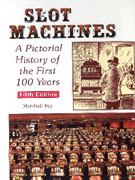The Joy of Six Slot simulates craps action
Microgaming's video slot release The Joy of Six allows players the chance to experience the excitement of the enthralling game of craps. Based in a casino environment, the five-reel, 30-payline slot lets players throw the dice in a vibrant world of vivid graphics, craps animations and distinctive sound effects. The large variety of features within the game gives players many opportunities to profit from an enjoyable experience.

Slot Machines: America's Favorite Gaming Device
by Marshall Fey
The complete and colorful story of coin-operated chance machines from the time they first became prevalent in the early 1890's up to the slot machines operated in today's casinos. Included in the exciting drama of this major industry are the pioneer, inventors, manufacturers, operators and the numerous raids that plagued the industry. This book has been used as a source book worldwide, including television documentaries.
Read a review of Slot Machines: America's Favorite Gaming DeviceVideo Poker - The Electronic Age
As we saw in our first part of the history of video poker, The Origins of the Game, draw poker machines were very popular games at the beginning of the 20th century. But once slot machines became more prevalent, the interest in draw poker machines declined. It would take the combination of video technology, microprocessors and the competition of giant slot manufacturers to reignite the popularity of a draw poker machine in a new format -- video poker. The game became a sensation and has legions of gambling fans to this day.
With Nevada Electronics' introduction of solid state "21" machines in 1964, modern technology began to have an impact on slot machine manufacture. Although the machines were not that popular with players, the industry kept working to perfect the technology and built solid state 21, dice, roulette, horse racing, and poker machines throughout the early 1970s. As a harbinger of things to come, one machine that captured the players' attention was Dale Electronics' Poker-Matic, which could be found in most Nevada casinos.
In 1975 Fortune Coin Company introduced the first video bell slot machine in Las Vegas. Casino executives were only mildly interested in the machine and purchased it primarily as a novelty. When eventually the machine was converted to a draw poker machine its potential became apparent. In 1976, Bally built a black and white video poker machine and eight months later the Fortune Coin Company countered with a color version of the popular game. The video poker revolution was beginning.
A driving force in the electronic games market and video poker was William "Si" Redd. The son of a Mississippi preacher, Redd ran a successful distributing company which he eventually sold to Bally Manufacturing. As part of the deal, Redd got Bally to agree to stay out of the video gaming machine market for 10 years. Bally thought they got the better of the deal because they didn't see that much potential in video technology.
Redd's new company, A-1 Supply, soon acquired pioneer video game manufacturer, Nutting Enterprises, and began building blackjack and draw poker console machines. The company flourished, and Redd changed its name to Sircoma (Si Redd Coin Machines). In 1981 Redd's company underwent another name change, this time to IGT (International Game Technology).
With a stranglehold on the video gaming, Sicroma and later IGT's Fortune slots and video poker machines dominated the industry from the mid 1970s to the early 1980s. In 1981, IGT had sold $32.5 million dollars worth of video poker machines. Eventually Bally Manufacturing got back into the game, but IGT was well on its way to being the biggest slot and video poker manufacturer in the world.
Redd, who died in 2003 at 91, said he never thought his inventions would become such a phenomenon. In an interview with John L. Smith, Redd told him "Everyone says, `Si Redd was a genius to think of the video poker.' Well, that's not true," he said. "The truth is, we had no idea that video poker would be half as good as it turned out to be. We started out with video keno and then blackjack. But what makes the poker work is the fact that it is more or less as liberal as a slot machine. People play the same amount of money, but unknowingly at first, we made the poker machine different. There are more buttons to push. It takes you a little longer to play, but you're getting a better entertainment value."
Over the years, Redd became enlightened about the dangers overexposure to video poker had on some players. It bothered him so much that he proposed programs to help those who were addicted. "We are selling amusement, but some people get addicted to it," Redd said. "We should add a $1 or $2 tax to each slot machine to help people who are addicted to it. It exists. The best way to handle it is to meet it head-on."
Video poker has evolved in many ways since the 1970s and 1980s. With the animation of cards in the 90s to the introduction of a myriad of new games including Deuces Wild, Joker Poker, and Bonus Poker, video poker continues to capture the imagination of gamblers worldwide. The latest innovations include multi-play hands and more entertaining game designs.
[ learn video poker! ]

